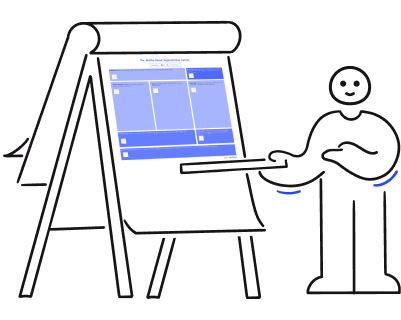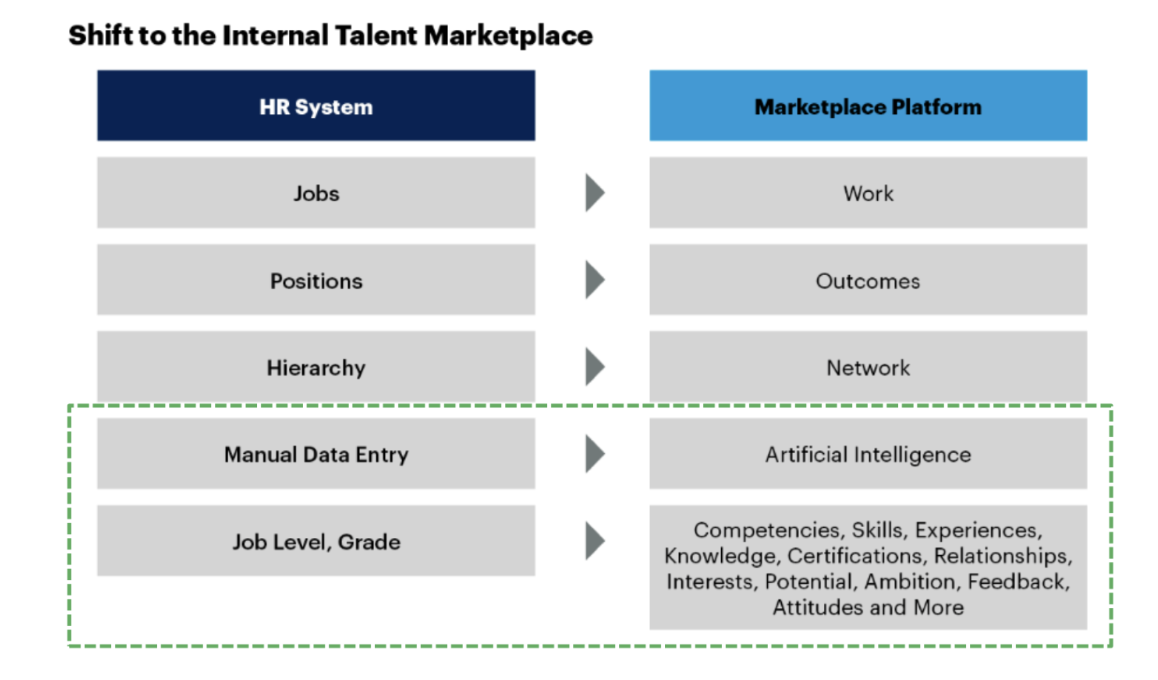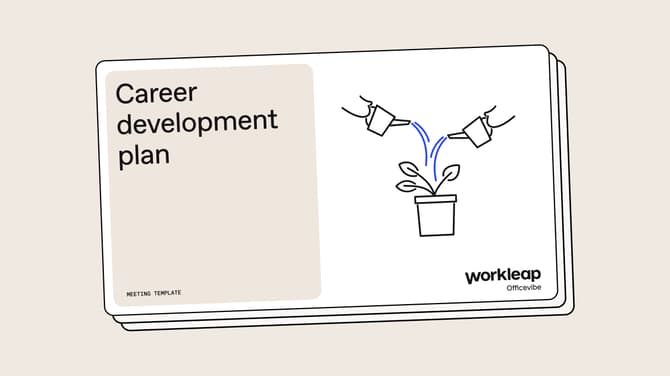Empower your organization with the skills-based canvas.

What's in this article
- Introducing Workleap Skills and the skills-based economy
- The rise of the skills-based economy
- 4 driving forces that will accelerate the shift to a skills-based approach
- The shift to a skills-based internal talent marketplace (ITM)
- Introducing Workleap Skills: Skill mapping and talent development made easy
Introducing Workleap Skills and the skills-based economy
Remember what running a business looked like just a few years ago? Pre-pandemic days feel like another world, almost like a figment of our imagination.
These days, small business owners and HR leaders are witnessing a massive transformation of the workplace and the workforce, setting the stage for the greatest shift in the organization of work since Henry Ford’s design of the assembly line. And the next decade will continue to shift the way we work and where work happens.
As organizations become more dispersed and diverse, it is imperative for all of us to rethink our ways of working and, most importantly, how we evaluate our talent and push our teams forward.
The rise of the skills-based economy
The evolution of the workforce and the jobs of the future all point in the same direction: toward skills. In the coming years, skills will become the lifeblood of high-performing teams and the currency of a new economy.
This next economy will be powered by talent mobility and the ability for companies to organize work in real-time to meet the challenges of today and tomorrow – a shift that I believe will advantage small and medium-sized businesses (SMBs) that display greater agility and adaptability.
In this new era of work, talent mobility will be a function of organizations’ ability to assess their employees’ skills and match them with current work assignments, while developing and accelerating new skills for future needs.
As Alex Kaplan, global leader of Blockchain and AI for Industry Credentials at IBM said: “If skills are going to be equivalent to currency, it’s necessary to create an infrastructure with “trust, provenance and transparency”.
He’s right. Organizations need one source of truth where all their employees’ skills can be assessed and developed transparently, without bias.
That’s why my team and I have created Skills: to build the foundational software that will power the generational shift toward a skills-based economy (more details below).
Our end goal: give companies the necessary information about their people’s skills so that they can instantly assess the changing need for jobs, make consequential strategic decisions (from hiring, upskilling/reskilling to workforce planning and beyond), and thrive in an increasingly volatile market.
A solid HR strategy can be one of the most defensible competitive advantages.
And a skills-based approach will be your secret weapon at the decision table.
4 driving forces that will accelerate the shift to a skills-based approach
New ways of working and expectations
The pandemic-fueled adoption of remote work went from short-term experiment to new normal in a matter of months.
As evidenced by a 2022 Pew Research study, after two years into the pandemic, roughly 6 in 10 U.S. workers who say their jobs can mainly be done from home (59%) are working from home all or most of the time.
The perception about remote and hybrid work has completely shifted, and it’s now the golden standard for most knowledge-based companies in the post-pandemic era.
As a result, it’s reshaping the entire employee experience and poses a huge challenge for HR leaders. And we’ve yet to measure the full magnitude of second-order consequences that will come in the aftermath of such drastic change. But all the data points in the same direction: people are actively seeking more engaging and fulfilling workplaces. 61% of US employees are considering handing in their resignations in 2023, according to a LinkedIn survey. What analysts call the “great resignation” or “great reshuffle” is still in full effect in 2023.
What’s more? Some employees feel lonelier than before. In his thought-provoking piece titled “Work from Office”, NYU Professor Scott Galloway highlighted this new challenge: “Without a workplace, your employees have fewer points of contact. Sixty percent of remote workers say WFH makes them feel less connected to their colleagues.”
Remote and hybrid work is here to stay. And the benefits are undeniable (greater productivity, flexibility and work-life balance to name a few). But we need to find new ways to foster collaboration and growth to avoid the common pitfalls of not working from the office. A lack of career progression, a drop in employee engagement and motivation, siloed work, a lack of connection, and reduced visibility on skills and accomplishments are together the new villains that HR superheroes must fight on a day-to-day basis. So, we need to develop software that gives superpowers to our HR leaders (guess what, we are working on that!).
Greater talent mobility and skills-based career pathing and mentorship are two ways to create stronger bonds in the workplace to make remote work feel more connected and fulfilling.
Rapid technological change
Tech disruption and AI are on everyone’s lips these days, and rightfully so. We are just starting to see the tip of the AI iceberg but the disruption will be real (ChatGPT is not just an overnight sensation; it’s a reminder of the exponential nature of progress in the age of AI).
From writing emails to blog posts to coding in python, AI will change the face of many jobs or acting as a copilot for many others. The need to reskill and upskill will become table stakes in the next decades, as career trajectories will adapt to the acceleration of AI adoption and disruption across various industries and jobs.
Beyond that, having a solid AI strategy that focuses on augmenting employees and accelerating their unique skills will be a key competitive advantage as we enter the next iteration of the hybrid workplace (i.e., AI-augmented humans).
Technology is both an opportunity and a threat. The rapid pace of change forces small businesses to constantly adapt to keep up the pace. Embracing change is no longer an option, it’s a business imperative. And we are on a mission to give Fortune 500 capabilities to the Fortune 500,000, so that you can use technology as your trump card, and thrive in the face of change, not just react to it.
A heightened focus on profitability
After a historic bull run, the tailwinds have shifted. The economy is now facing major headwinds, and businesses must be more frugal. Overhiring, especially in tech, will soon be a thing of the past. So, the pressure on organizations to do more with less will be a key strategic driver.
Mapping skills to fully grasp an organization’s capabilities and double down on internal resources (vs. outsourcing or hiring new ones) will be critical to running a tight ship and maximize team performance in the coming years.
An economic slowdown could actually turn out to be good for the progression of certain employees who will be called to take on more responsibilities in order to meet the challenges of the times. Upskilling is a win-win for both business and personal growth, as more companies try to get the most out of their workforce to show profitability.
But profitability shouldn’t come at the expense of progress. True leaders emerge in uncertain times, and having a clear view of your talents to understand who can step up their game and play a bigger role will be paramount to your success as an organization.
Talent wars
Top talent is rare. And labor shortages will be an enduring challenge for HR leaders in the next decade.
As you know, business success today revolves largely around people, not just capital. More than ever, the employee experience is a driver of business performance. In fact, according to Harvard Business Review, “a decade of research proves that happiness raises nearly every business and educational outcome: raising sales by 37%, productivity by 31%, and accuracy on tasks by 19%, as well as a myriad of health and quality of life improvements.”.
Taking care of business starts with taking care of your people. It’s simply non-negotiable in this day and age. Even more so if you are a small business. Talent is the number one competitive advantage that can turn small seeds into mighty trees. With the right team, you can achieve even your wildest dreams. I have experienced this firsthand as the cofounder of Workleap (home of Officevibe, ShareGate, Onboarding, LMS, and now Skills). We built it into a $100M annual revenue business with only 250 employees. Our talents made it possible.
Hiring, onboarding, and offboarding (whether because the employee was laid off or poached by another company) are huge costs that businesses can’t afford in a tougher economy. So attracting the right people and helping them develop mission-critical skills while ensuring their happiness at work is the perfect trifecta for business success today.
The 4 pain points that HR leaders can solve with SkillsTech:
- Tedious and inaccurate skill mapping: Skill mapping at the organizational level can typically take months of manual work. It also tends to be outdated the minute it is completed due to constant changes in the makeup of your workforce. With the rise of AI and skill mapping tools like Workleap Skills, HR leaders and managers can now map their entire organization’s skills in a matter of minutes. And update them on the fly as the business evolves in real time. Not only skillstech can save you a ton of time but it also reduces biases while ensuring great accuracy across the board and over time.
- Reactive workforce planning: Traditional workforce planning is typically a yearly process that involves forecasting based on unknowns. Skill mapping eliminates guesswork by giving you a data-driven view of your workforce in real time so that you can get a 360-degree understanding of your needs and gaps. That way, you can take a more proactive and evolutive approach to workforce planning vs. being reactive or, worse, sticking to an outdated plan that doesn’t meet your workforce needs.
- Lack of employee engagement and retention: We talked about it abundantly in this article but this should be every organization’s north star. An engaged workforce is a productive workforce. Taking care of your people is taking care of your bottom line. At the end of the day, every investment in your talents is an investment in your business and future. Skill mapping can help you create tailored progression plans for your employees by identifying their strengths and weaknesses and have a data-driven conversation with them around career growth and their next milestones. It creates tangible steppingstones and objectives to help them get to the next level and keep them engaged at all times. In the end, it’s all about making the most of your workforce and empowering them to do their best work.
- Lack of internal mobility and visibility: As your organization scales, it’s increasingly hard for your talents to identify and seize new opportunities – especially in a remote-first setting. It’s the employer’s responsibility to put in place tools and strategies to unlock greater mobility and visibility so that your team and business can reach their full potential. Whether it’s using skills to recommend roles, match employees with relevant mentors or encourage employees to work on applied learning projects, skill mapping is the cornerstone to developing an active internal talent marketplace that keeps your team engaged and fulfilled.
86% retention increase
Companies that excel at skill-based internal mobility retain employees for an average of 5.4 years, nearly twice as long as companies that struggle with it, where the average retention span is 2.9 years. — Source: LinkedIn 2022
We all have a “star employee who got away” story. It happened to me more than once, and it hurts every time. Lack of visibility into a team’s projects and skills can lead to highly capable employees leaving for the wrong reasons. That’s why we created Skills: to enable employees to be their best selves and create more fulfilling careers and workplaces.
The shift to a skills-based internal talent marketplace (ITM)

Skills are the new atoms and economic units of organizations. As work increasingly becomes organized around skills not jobs, we can start shifting our mindset to achieving outcomes, not just filling positions. We believe this is the first step to making work more meaningful.
Skills are also the great equalizer that will enable organizations to diminish their overreliance on hierarchy and, instead, to build networks of trust that unlock greater mobility and collaboration across departments. Silos are the enemy of skills-based organizations, and they must be broken down.
In other words, organizations will become more of a *network of skills* and less of a hierarchy. The future will be made up of people who move around more fluidly within the business so that their skills can be put to use in real-time on the best projects, products and strategies that will deliver the highest impact for the company.
In this new way of working and managing the workforce, skills become the heartbeats of the modern-day employee experience – putting greater emphasis on competencies, knowledge, certifications, interests, ambition, feedback, attitude and aptitude, and most importantly on relationships.
It’s also a shift in organizational mindset, eliminating cultures that:
- Focus on permission over forgiveness.
- Value expertise and perfection over personal growth and learning.
- Are overly oriented toward micromanagement and strict top-down control of employee behaviors vs. employee empowerment and ownership
The trend toward an employee-tailored workplace is just getting started. And skills will level the playing field, while helping to create a culture that treats employees like the unique individuals they are, not like numbers in a spreadsheet or HRIS.
In the end, it’s all about building an actionable and seamless talent marketplace platform that favours talent mobility, “just-in-time” workforce planning, and unbiased career progression – no matter your gender, race, religion, or sexual orientation. And Workleap Skills is designed to do just that by removing the guesswork and giving equal opportunities to all.
Introducing Workleap Skills: Skill mapping and talent development made easy
In the previous paragraphs, I focused on the “why” behind our product but not on the “what” and “how”. What is Skills after all? Let’s take a look…
Workleap Skills was built to empower people-first teams to map their skills, develop their talents, and accelerate their growth to create more fulfilling and productive workplaces.
Our platform is built around 4 core pillars:
- AI-enhanced skill mapping: Workleap Skills is like a magic wand for skill mapping. With a simple interface and a dash of AI, you will get a clear and instant view of your team’s capabilities and blind spots. More concretely, we crunch more than 55 million job postings and data points to identify the skills that make up the crucial roles in your organization. Our easy-to-use drag-and-drop interface enables your employees and colleagues to make their own self-assessment to create a 360 view of their current skills and gaps.
- Talent development & retention: Skills helps you identify the next stepping stones in your employees’ careers and formulate clear career progression paths so that every employee can reach their full potential. For example, if a leadership role requires expert-level communication skills and a senior developer is only at the intermediate level in this area, this can be an area of focus to work on in the next few quarters to be able to get to the next level of their career.
- Internal mobility (ITM) & mentorship: Workleap gives you a crystal-clear view of your team’s skills and capabilities. It also doubles as an internal talent marketplace that pairs your talents with the right mentors and projects so that they can propel their career and your organization forward.
- Workforce planning: Workleap Skills gives you real-time data on your workforce’s current skills and gaps so that you can plan your next hires accordingly. It makes workforce planning more data-driven and proactive as opposed to set in stone based on an imperfect yearly assessment.
Plus, our easy-to-use platform seamlessly integrates with your existing workflows so that you can focus on what really matters: your people. With more than 35 HRIS and ATS integrations, we make skill mapping, workforce planning & career development as hurdle-free and effortless as can be.
The HR tech landscape is filled with vapourware and expensive black box enterprise solutions that, in the end, fail to deliver tangible business value and takes months to deploy.
With Workleap Skills, we wanted to flip the script by creating a free-to-start, plug-and-play, and instantly available skill mapping solution for SMBs. With a freemium model and democratized price point, Skills enables you to map your skills in a matter of minutes, not months. It is an order of magnitude faster, easier to use and cheaper than manual labor or expensive enterprise solutions.
With Workleap Skills, you can make skills the currency of your workplace and unlock your team’s full potential as soon as today.
To learn more, get a test drive with one of our product specialists, who will be happy to help and answer your questions.
Monitor, support, and optimize your team's professional development.




